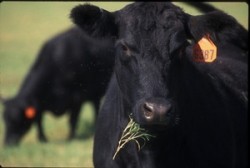USDA grant aided research looks at novel feeding schedule for monensin

The project is one of a series of 40 grant aided initiatives announced by the US Department of Agriculture (USDA) and awarded through the National Institute of Food and Agriculture (NIFA). Total funding for the grant series was around $15.7m.
The project builds on past work with monensin and focuses on improving the performance of forage fed or grazing cattle, said Natasha Bell, corresponding researcher and assistant professor in the Department of Animal, Rangeland and Wildlife Science at Texas A&M University.
The project examines the use of monensin on a periodic basis rather than as a continual feed additive, she told FeedNavigator. The goal is to explore the novel feeding regime to extend the usefulness of the feed additive for a longer period.
“We hypothesize that because the greatest impact of monensin feeding occurs 7-14 days after commencing monensin inclusion, and because improvements are not noted after 14 days withdrawal from the diet, cyclic feeding of monensin will allow us to attain the benefits of monensin for a prolonged period of time without observing the diminished effects common with long-term continual monensin feeding,” Bell said in the grant proposal. “This would suggest that monensin resistance that is observed with long-term continual feeding is reversible and therefore non-heritable, thus potentially alleviating the concern over antibiotic resistance and public health in regards to ionophores.”
Unlike much of the previous work with monensin, the study focuses on grazing cattle, rather than feedlot production, she said. “I find it a useful additive for producers and a lot has been done with it in feed yards, but not so much with grazing,” she added.
“I work with grazing animals instead of feed yard animals,” Bell said. “We know [monensin] is really effective with grazing animals – but most grazing operations aren’t feeding daily, they’re grazing, and this would allow them to feed it intermittently rather than feeding it all the time. It would reduce the amount of labor it would be easier with them as well.”
Additionally, the supplement may offer producers a chance to use less expensive ration to supplement poor quality forage, she said. Monensin use could cut some reliance on proving supplemental protein to grazing cattle.
“It improves forage utilization and that’s the benefit to grazing operations,” she said. “We have a lot of low quality forage for most of the year – we’re looking for ways to improve the animal’s ability to utilize forage.”
Monensin feeding trial specifics
The $150,000 grant is considered a seed grant, which is focused on preliminary research efforts, said Bell.
“If the results look good I have plans for subsequent studies so I’m excited to see what we find from this one,” she said.
The feeding trials will involve use of 12 cows fed one of three diets for a four-month period, said Bell. One control group will have a diet not supplemented with monensin; one group will have the additive continually and the third group will get the additive on a rotating basis, with two weeks of supplementation and two weeks without.
During the feeding trial cows will be assessed for intake, digestion and ruminal fermentation, Bell said in the grant proposal.
It has been previously noted that monensin ceases to be effective when used continuously in cattle diets over a period, she said. However, there is some discrepancy in how long that period is.
“We’re going to do four periods of 28 days,” she said. “By the end of four months we’ll see that there aren’t any effects anymore on continuous dosing.”
One goal of the feeding trial is to examine a potential way to extend the usefulness of the additive, she said. Once monensin is removed from a cow’s diet, it takes about 14 days for the cow to match a cow that has not received the additive.
Findings from the feeding trial also may offer support to the use of ionophores in animal diets, said Bell. “There are a lot of public concerns that ionophores will cause antibiotic resistance but we know that they’re not like the other antibiotics,” she added.
Part of the study will involve examining the microbial populations in cattle getting or not receiving the monensin supplement, she said. The project also will allow for comparison of those microbial populations.
“If in fact they’re becoming resistant we’ll see a slow change, and their populations when they’re not on monensin will be different,” she said. “But if [the microbial populations] come back to normal, it would provide information that there is no resistance forming.”















